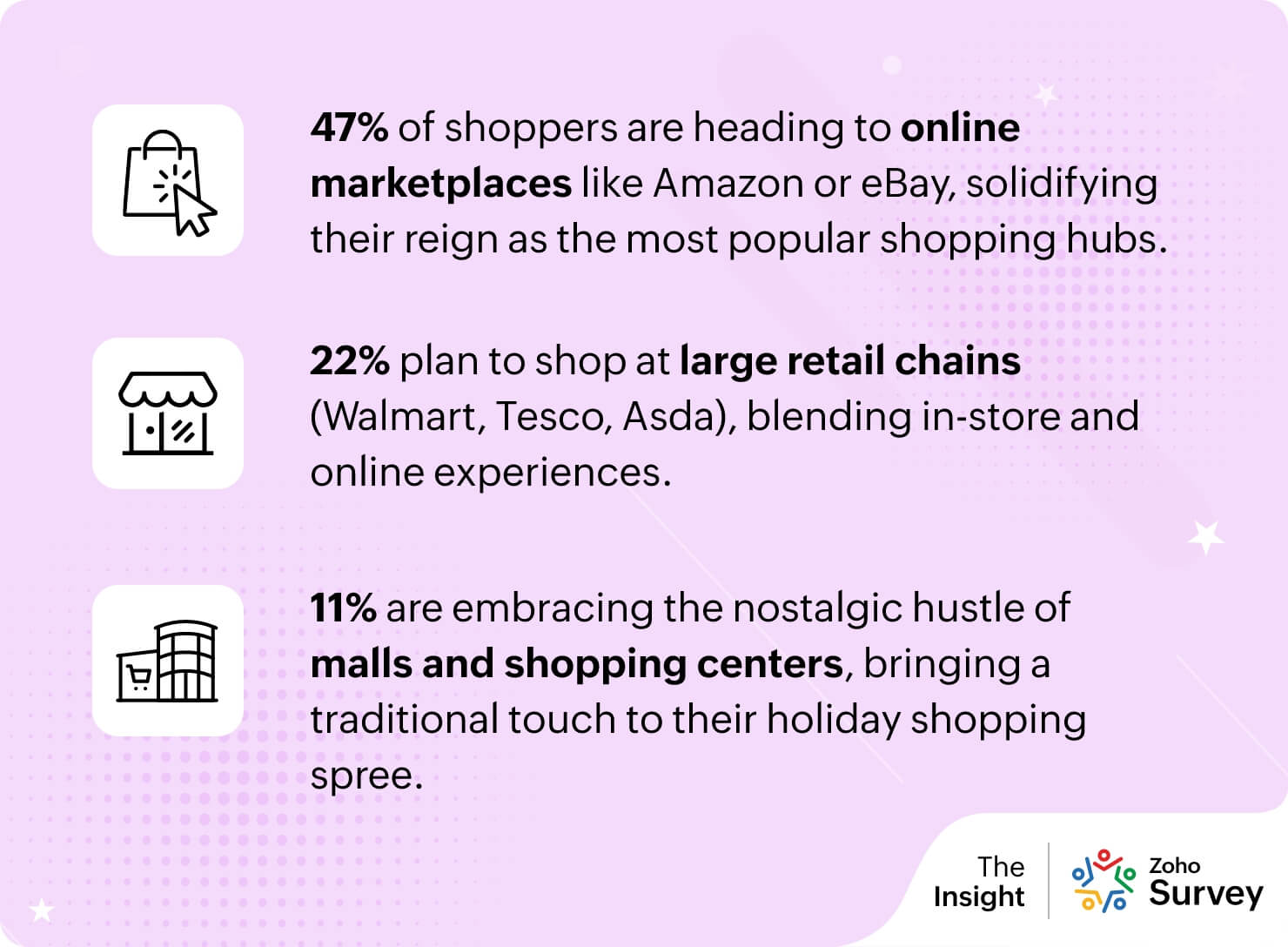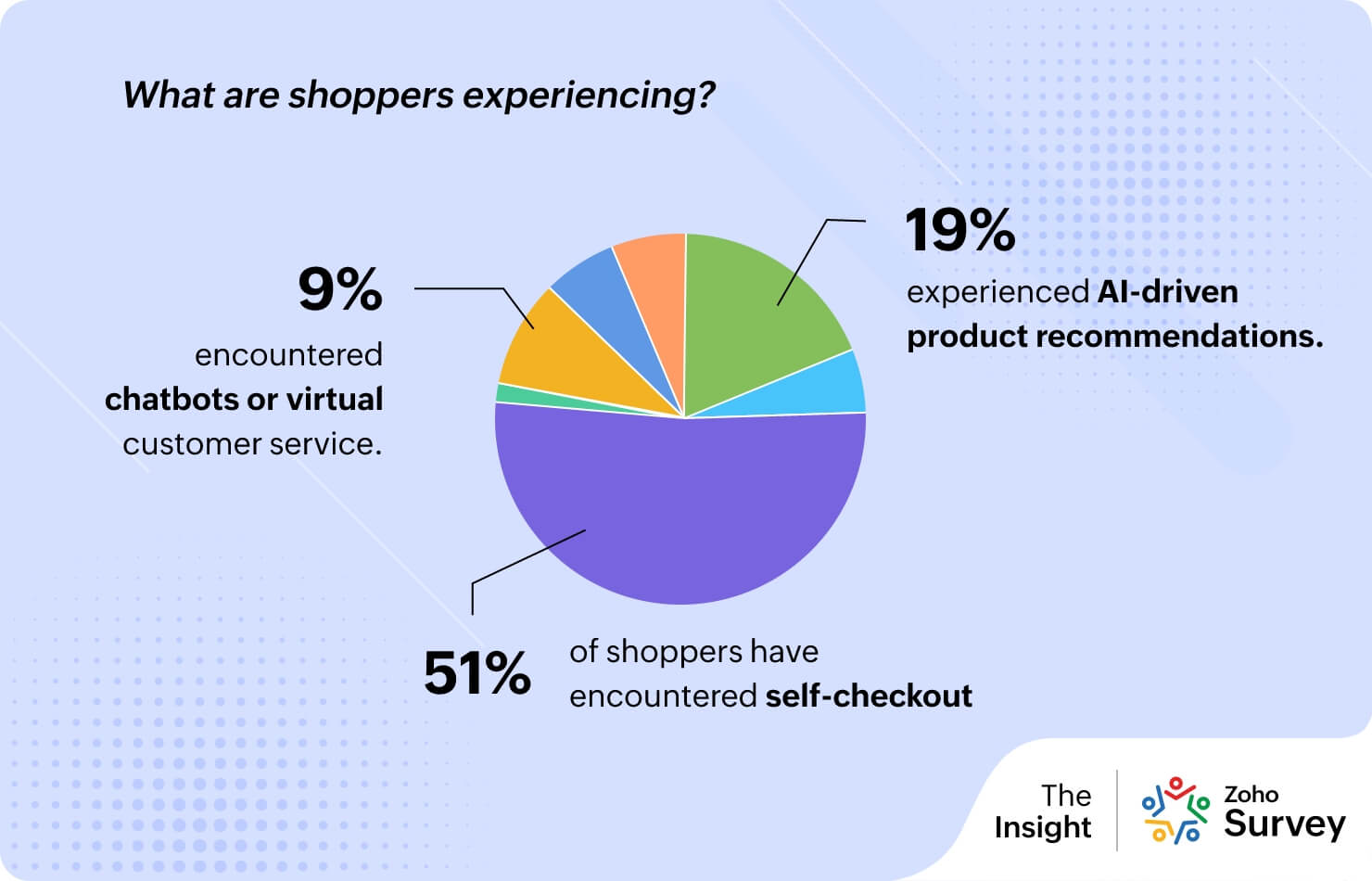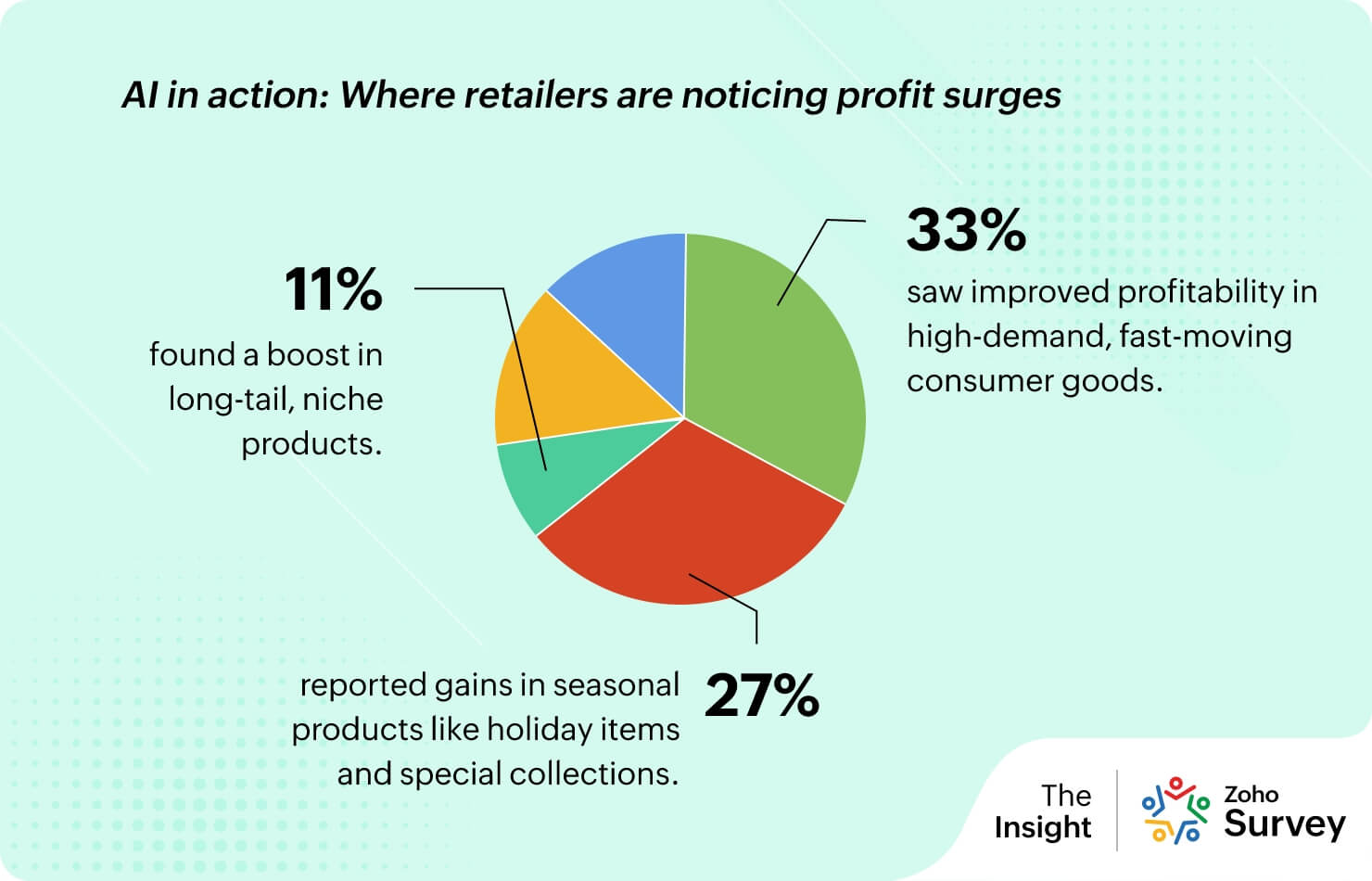- Where are shoppers headed this season?
- Tech transformations: What are shoppers experiencing?
- AI personalized shopping
- Through the retailer’s lens: How AI is transforming the retail business
- The AI hurdle: Navigating through the complexities of innovation
- The road ahead: Where is AI taking us?
Where are shoppers headed this season?

It’s interesting to note that despite the buzz around influencers and online communities, social commerce is still in its early stages, with just 1% of shoppers planning to make purchases through platforms like Instagram or Facebook.
Tech transformations: What are shoppers experiencing?

While the tech world buzzes about AI and futuristic innovations, shoppers seem to prefer more grounded solutions—self-checkout kiosks remain the clear front-runner. These kiosks, blending convenience with efficiency, have seamlessly integrated into the shopping experience.
However, AI-driven recommendations are beginning to make their mark, with shoppers already engaging with personalized suggestions. Although still in its early stages, it’s clear that AI is slowly weaving its way into the retail experience, nudging consumers toward tailored products. Chatbots are also seeing traction, providing quick customer service that saves time for both shoppers and retailers alike.
Now, the real question is: how are people actually feeling about these AI-powered shopping experiences? We wanted to dig deep and capture the full spectrum—the good, the bad, and everything in between. And shoppers didn’t disappoint.
Here’s what sentiment analysis reveals:

AI personalized shopping
With the rise of collaborative filtering-based (CFB) algorithms, hyper-personalized ads have become the most interacted-with form of AI technology. Overall, shoppers’ experiences with it have been mostly positive, though a few have expressed neutral or unsatisfactory encounters. Here’s how the technology is resonating with those who’ve felt its benefits firsthand:
“They helped suggest items I didn’t know about and made the decision-making process easier for me.” For many, AI has simplified shopping, making it easier to uncover new items and make quicker choices.
“It helped me narrow down my search.” AI’s efficiency is a big plus, guiding shoppers to what they need without the hassle of endless browsing.
“It zeroed in on exactly what I wanted. It’s reduced an activity that often takes an hour of thinking to a few seconds. AI is incredible technology.” The speed and accuracy of AI recommendations are transforming decision-making, bringing convenience to a whole new level.
While many shoppers have welcomed AI’s assistance, not everyone has had a prefect experience. Some have voiced concerns, sharing the less favorable side of AI personalization.
“Far too intrusive.” For some, the personalization crosses a line, leaving shoppers feeling uncomfortable with just how much AI seems to know.
“The suggestions were irrelevant to me.” Not all recommendations hit the mark—some shoppers found that AI’s choices missed their preferences entirely, making the experience less helpful.
In fact, 73% of shoppers mentioned they would prefer a friend’s suggestion over an AI recommendation, showing that the human touch still holds sway in decision-making.

For most shoppers, experiences with chatbot assistance have been either positive or neutral, offering quick answers and basic support when needed. While many found the technology useful for simple tasks, a few noted areas where it fell short, especially when complex issues arose.
“Helps without human interference.” For many, chatbots make getting assistance simpler and more convenient by eliminating the need to wait for human intervention.
“I think it cuts the wait along trying to ring someone from customer service.” Reducing wait times is a major benefit, as shoppers appreciate the quick access to help without needing to place calls or navigate long wait queues.
“It gave me some details that were not in the product description.” Chatbots are also adding value by providing additional product information, helping shoppers make more informed decisions.
While chatbots provide quick support for many, not all shoppers are satisfied with the experience, and some express a clear desire to have the option to interact with a human.
“I cannot stand having to break through a chatbot in order to reach an actual associate,” said one frustrated shopper. “It’s so frustrating. They ask a million things, which brings you around in circles, and they respond with 2 options, which don’t apply to your quotation. It’s maddening.”
Through the retailer’s lens: How AI is transforming the retail business
While shoppers are navigating these new AI-powered experiences, retailers have a story of their own. Behind the scenes, they’re leveraging AI not just to streamline operations but to enhance customer engagement and boost profitability. So, how are retailers adapting to this shift? We take a closer look at how AI-driven automation is reshaping their business—and what challenges they’re facing in the process.
AI in action: Where retailers are noticing profit surges
When it comes to profitability, AI is already actively boosting specific product lines. We asked retailers where AI-driven automation made the biggest impact, and here are the answers.

The data indicates that AI-driven automation has positively impacted a variety of product lines, particularly those in high-demand categories. Retailers are leveraging AI to keep fast-moving consumer goods efficiently stocked and priced, ensuring they capitalize on consistent demand.
Seasonal products have also benefited from predictive analytics, which make it easier for businesses to plan and promote limited-time offerings. Even niche, long-tail products have seen profitability gains, suggesting that AI helps retailers identify and serve smaller, specific market segments effectively.
Interestingly, more than 18% mentioned they’ve seen no noticeable impact from AI, which highlights that while the technology has great potential, it will take time to develop effective implementations across different retail sectors.
Yet, as promising as AI is, using this emerging technology doesn’t come without challenges. Retailers may be harnessing AI’s power, but the road isn’t always smooth. Behind the scenes, they’re confronting hurdles that make this transformation more complex than it seems.
The AI hurdle: Navigating through the complexities of innovation
The promise of AI in retail is undeniable, but getting there isn’t without its bumps.
For most businesses, the biggest stumbling block is the cost of implementation—from acquiring the technology to training staff, it’s an investment that many find hard to justify upfront. As a result, the lack of skilled talent capable of managing these sophisticated systems remains a pressing concern.
Another critical factor is consumer reluctance to adopt AI-driven services. Despite the advances in personalized shopping experiences, there’s a lingering hesitance, perhaps stemming from concerns over privacy, security, or just a lack of familiarity.
Even more telling is the difficulty in measuring ROI, with 48% placing it at the bottom, indicating it’s a persistent puzzle rather than a primary obstacle.
The road ahead: Where is AI taking us?
As retailers continue to embrace AI, it’s clear that it isn’t just a fleeting trend; it has been shaping retail in ways we couldn’t have imagined a few years ago. While the road has its twists, the benefits are becoming hard to ignore. So, where do we go from here? The possibilities are just getting started!









